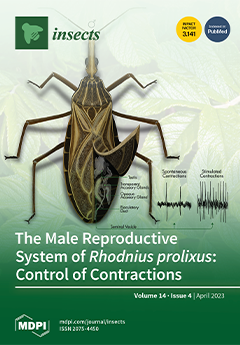Ecdysteroid hormones are key regulators of insect development and metamorphosis. Ecdysone-inducible
E75, a major component of insect ecdysone signaling pathway, has been well characterized in holometabolous insects, however, barely in hemimetabolous species. In this study, a total of four full-length
E75 cDNAs
[...] Read more.
Ecdysteroid hormones are key regulators of insect development and metamorphosis. Ecdysone-inducible
E75, a major component of insect ecdysone signaling pathway, has been well characterized in holometabolous insects, however, barely in hemimetabolous species. In this study, a total of four full-length
E75 cDNAs from the English grain aphid,
Sitobion avenae, were identified, cloned, and characterized. The four
SaE75 cDNAs contained 3048, 2625, 2505, and 2179 bp open reading frames (ORF), encoding 1015, 874, 856, and 835 amino acids, respectively. Temporal expression profiles showed that
SaE75 expression was low in adult stages, while high in pseudo embryo and nymphal stages.
SaE75 was differentially expressed between winged and wingless morphs. RNAi-mediated suppression of
SaE75 led to substantial biological impacts, including mortality and molting defects. As for the pleiotropic effects on downstream ecdysone pathway genes,
SaHr3 (hormone receptor like in 46) was significantly up-regulated, while
Sabr-c (broad-complex core protein gene) and
Saftz-f1 (
transcription factor 1) were significantly down-regulated. These combined results not only shed light on the regulatory role of
E75 in the ecdysone signaling pathway, but also provide a potential novel target for the long-term sustainable management of
S. avenae, a devastating global grain pest.
Full article






